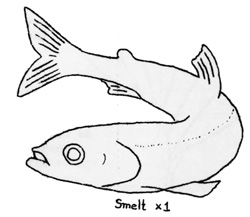

|
|
NATURE NOTES FROM ACADIA
In May, when the smelts are spawning in certain of the streams on Mt. Desert Island, one who observes this truly remarkable phenomenon cannot help but be impressed by it. The small greenish-backed fish begin their up-stream journey early in the night, when suddenly schools of them appear and begin to ascend the shallow brooks. The submerged rocks over which they pass become coated with the spawn of this determined finny multitude. So great do their numbers become that the onlooker would experience no difficulty in scoping up as many handfuls of the slender-bodied silvery-sided creatures as he might desire. Favored both as a choice food fish as well as excellent bait for the larger game fishes, the smelt is sought after by many. The countless numbers of eggs which this one kind of fish alone deposits - what becomes of them? It would be safe to say that if but one-half of the eggs were successfully hatched, and then if but one-half of these young reached maturity our streams, within the period of a few years, could not hold the unbelievably great numbers of smelts. Such a situation, however, does not arise. The odds against any form of wild life whose progeny is great in number are correspondingly great. In the spring our frogs and toads take to the water where the females lay from a few hundred to a few thousand eggs. These masses of potential life are deposited in shallow pools which not infrequently dry out leaving the egg clusters stranded. Then, too, various forms of life are known to prey upon the eggs. Those tadpoles which finally wriggle free of the gelatinous mass wherein they were cradled find a host of enemies both in the water as well as upon the land, and the ones of their number which are able to successfully run the gauntlet of hostile predators are few indeed. It is no wonder that their kind does not become noticeably greater in numbers as the years go by. 
The herring will lay many thousands of eggs while the cod, the oyster, and certain starfishes are known to deposit millions. Orchids produce great numbers of fine seeds and certain of our puff-balls release myriads of dust-like spores. Yet, in spite of this great reproductivity the numbers of the various animals and plants remain at a remarkable level over a long period of years. Certain animals, like the lemmings and rabbits of the far north are well known to increase periodically until their numbers become unbelievably great, but the pendulum of the so-called and non-existant "balance of nature" then begins the back-swing, and before long these animals become correspondingly few in number. So here too, in spite of pronounced fluctuations, a certain equilibrium in numbers is maintained. As the poet has implied, Nature, though seemingly careless of the individual, guards with utmost care the mold in which its form was cast, be it frog or flower, lemming or smelt. It is a part of the drama of the out-of-doors. |
| <<< Previous | > Cover < | Next >>> |
nature_notes/acad/vol2-2c.htm
09-Jan-2006